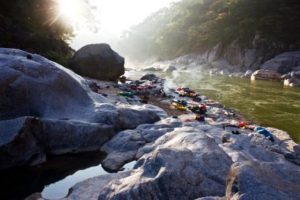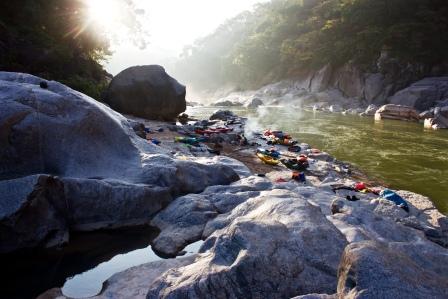One of the good things happening in Meghalaya is that the local people are joining hands to address environmental issues.
The growing numbers of community-led River Protection and Conservation movements in Meghalaya are rays of hope for the state, known as ‘The Abode of Clouds’ and for those living near the rivers. Sfter all, water is the basis of life on earth.
This month, October 21, saw Rally for Umngi: A River Conservation Movement organised by Friends of the Umngi River at the Synod College, Shillong, where community leaders had the opportunity to learn from experts on the need and benefit of protecting our river system.

The movement for conservation of Umngi is unique. It is not only community-based but it is also community-led. Over 20 villages form the integral part of the project. The state government lends its support through the offices of the SDO Ranikor C&RD Civil Sub Division (under the leadership of FB Basan) and the District Commissioner South West Khasi hills. It is a movement in which the villages, the Raij and the Hima in the area have taken upon themselves the responsibility to protect and conserve the approximately 50 km long stretch of the downstream segment of the Umngi River.
Poaching fish by throwing explosive devices had become rampant. The Friends of the Umngi River (FoTUR) with the help of the District Administration of South West Khasi hills were able to stop poachers who used dynamite kill fishes in the river. FoTUR not only works to protect and conserve the river Umngi, but it also conducts studies to understand the entire river system.
Studies have been done on the aquatic life in the area by Robert Basan who is one of the leaders of the FoTUR. There is of course, opposition by vested interests. In an attempt to thwart the community’s effort to protect the river, Robert was attacked by unscrupulous elements who were against this noble endeavour.
Colleges like the Synod College and St. Anthony’s College, led by their teachers have also conducted research on the river system and the aquatic life in some areas of Meghalaya.
Dr Bashida Massar, Assistant Professor, St. Anthony’s college who is from Lapalang a border village in the East Khasi hills District had done a commendable job of documenting the fishes in the two rivers in the area namely Rymben and Borhil . Dr Richard Lyngdoh Assistant Professor, Synod college, Shillong and students from Synod college are engaged in a similar project at Darang village of West Jaintia hills district.
Part of Dr Massar’s UGC supported project was also to make students aware of the river system and the variety of fishes that are available in the area. Dr Massar also engaged students from the local schools in the project. She learned that the local students had more knowledge about the river and the fishes in the area. Her plan was to incorporate the indigenous knowledge related to rivers and the aquatic life in the area as part of the study.
Dr Massar’s aims to begin a conservation project in the area to protect the diverse aquatic life in the different rivers of West Jaintia Hills. Some fish, like the chocolate mahseer are in the list of endangered species as per the IUCN red list. She hopes that with coomunity support, they will be able to protect the various fish species in the area without disturbing their habitat.
The conservation and protection efforts by the Jaintia Fishing and Environment Society are also showing fruit. The organisation has successfully conserved the stretch of river Myntdu which goes around Jowai town. The organisation’s recent project was improvement of one portion of the river while giving more focus on the historic Syntu Ksiar. JFES has been able to creat a recreation space on this portion of the river which also adds to the beauty of the area, already a prominent tourist spot in the state. The organisation effectively stopped fishing on the Syntu Ksiar part of Myntdu and now the fish population has visibly increased.
But Myntdu is also a river which has to bear the brunt of abuse and f Acid Mine Drainage, therefore downstream, the river is toxic and no aquatic life can survive. Its water is not fit for human consumption anymore.
The rivers in Jaintia hills are classic cases of how the upper riparian population can jeopardize all the efforts made by the lower riparian residents. The lesson we learn from Jaintia hills is that river protection must start from the source and continue downstrream. T Robert Basan the leader of FoTUR is right to be concerned about the way people who live upstream of the river Umngi treat the River.
Under the Sixth Schedule, rivers fall under the jurisdiction of the District Councils. Protection conservation of the rivers is the Councils’ mandate, but till now none of the ADCs have made river protection laws. In Jaintia hills the JHADC to annually ‘awards’ the river on lease to the highest bidder. These ‘bidders’ try to extract maximum profit from the deal including using dynamite and chemicals to extract fish. This mass killing of fishes in the river is certainly not in the interest of the tribal people.
If the councils or the state government fail in their duty to protect the rivers, then the judiciary will have no other option but to step in as the NGT has done in the case of upstream of Myntdu River which flows around Jowai. Thanks to the NGT order, now construction less than 500 meters from the body of the Myntdu River is strictly prohibited. It is to bee seen whether this will be implemented in letter and spirit.
FoTUR is one story that needs to be told and replicated. We therefore need to include more friends of the Umngi River throughout its length and breadth if we are to really protect the river. In fact why should it only be Umngi River? We need to start more friends of the river organisations all across the state which will work to protect all the rivers.
It is high time that political parties start putting such issues into their election mandates. Governmnet of the day must support efforts to protect and conserve rivers all in the state. It should also actively promote community led efforts that will ensure community ownership.



Best efforts by the local people of Meghalaya and best part is that politician and some of the organisation has involved in it for protecting and conserving the River.
This kind of efforts should be done on entire country.